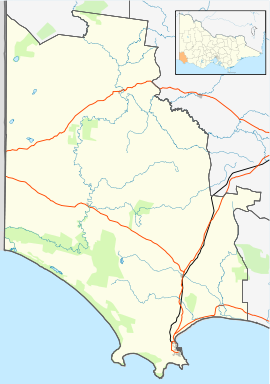Portland, Victoria
|
Portland Victoria |
|||||||
|---|---|---|---|---|---|---|---|

Bentinck Street, looking north
|
|||||||
| Coordinates | 38°20′0″S 141°36′0″E / 38.33333°S 141.60000°ECoordinates: 38°20′0″S 141°36′0″E / 38.33333°S 141.60000°E | ||||||
| Population | 9,601 (2011) | ||||||
| Established | 1834 | ||||||
| Postcode(s) | 3305 | ||||||
| Location |
|
||||||
| LGA(s) | Shire of Glenelg | ||||||
|
|||||||
Portland /ˈpɔːrtlənd/ is a city in Victoria, Australia, and is the oldest European settlement in the state. It is also the main urban centre in the Shire of Glenelg and is located on Portland Bay.
The bay was named in 1800 by the British navigator James Grant, who sailed in the Lady Nelson along the Victorian coast. "I also distinguished the Bay by the name of Portland Bay, in honour of His Grace the Duke of Portland," wrote Grant. The bay, the only deep sea port between Adelaide and Melbourne, offers a sheltered anchorage against the often wild weather of Bass Strait.
By the early 19th century, whalers and sealers were working the treacherous waters of Bass Strait and Portland Bay provided good shelter and fresh water which enabled them to establish the first white settlement in the area. Whaling captain William Dutton is known to have been resident in the Portland Bay area when the Henty clan arrived and is said to have provided seed potatoes for the Henty garden.
In 1834, Edward Henty and his family, who had migrated from England to Western Australia in 1829, then moved to Van Diemen's Land, ferried some of their stock across the Strait in search of the fine grazing land of the Western District.
After a voyage of 34 days, the Thistle arrived at Portland Bay on 19 November 1834. Edward Henty was only 24 years old and, early in December, using a plough he had made himself, he was the first white man to turn a sod in Victoria. The next voyage of the Thistle brought his brother Francis with additional stock and supplies, and in a short time houses were erected and fences put up.
...
Wikipedia

